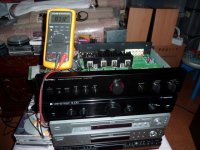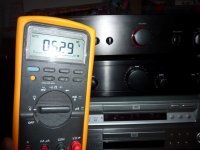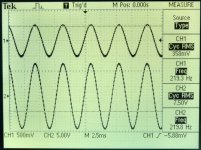Find a dummy load of 8 ohm and test the amp yourself. I have a couple of those oil filled radiators that are used for electric space heaters. They have 9 ohm elements and can take plenty of power.
Dummy load is not the problem, how to they determine max output when you have a variable output?
With the risk of me sounding stupid, if I use my amp now and feed it with 1kHz and volume @ 1/4 I am not going to get max output. It is a variable output, so how do manufactures claim 105w or is this done at maximum output?
With the risk of me sounding stupid, if I use my amp now and feed it with 1kHz and volume @ 1/4 I am not going to get max output. It is a variable output, so how do manufactures claim 105w or is this done at maximum output?
Last edited:
Dummy load is not the problem, how to they determine max output when you have a variable output?
With the risk of me sounding stupid, if I use my amp now and feed it with 1kHz and volume @ 1/4 I am not going to get max output. It is a variable output, so how do manufactures claim 105w or is this done at maximum output?
Or do you have a scope hooked up to the speaker output and do the measurement just before clipping?
Sorry think I have just answered my own question.
Is this the correct way, 8r load with a 1kHz input and a scope hooked up to the sp out. And you take the measurement just before clipping? And from the scope volts per div, you should be able to work out power output?
I have no shame in asking if I don't understand, I am young in electronics and there always seems to be a hierarchy that I hate.
Same at work, some of the lab engineers have all the time and will explain their design, where as others take offence if you don't understand.
Good example as I work in manufacturing, I pointed out to the design engineer that during manufacturing he was getting a solder short across an input capacitor and it was taking out the voltage regulator as the design would just keep adding more power. I asked if he could add protection to this ic and was basically undermined.
If there is a problem with another circuit designed by another engineer, he would understand and try to redesign or if I don't understand they will explain why this would happen, and give me pointers
I know this happens in all industries, but when you are keen to learn, why do people make it harder for you to learn. Going on one I know.
Is this the correct way, 8r load with a 1kHz input and a scope hooked up to the sp out. And you take the measurement just before clipping? And from the scope volts per div, you should be able to work out power output?
I have no shame in asking if I don't understand, I am young in electronics and there always seems to be a hierarchy that I hate.
Same at work, some of the lab engineers have all the time and will explain their design, where as others take offence if you don't understand.
Good example as I work in manufacturing, I pointed out to the design engineer that during manufacturing he was getting a solder short across an input capacitor and it was taking out the voltage regulator as the design would just keep adding more power. I asked if he could add protection to this ic and was basically undermined.
If there is a problem with another circuit designed by another engineer, he would understand and try to redesign or if I don't understand they will explain why this would happen, and give me pointers
I know this happens in all industries, but when you are keen to learn, why do people make it harder for you to learn. Going on one I know.
Last edited:
You run the output voltage up until you reach a specified limit. Usually that's either a THD number or waveform clipping. That is your maximum power.
Is this the correct way, 8r load with a 1kHz input and a scope hooked up to the sp out. And you take the measurement just before clipping? And from the scope volts per div, you should be able to work out power output?
Yes, its just as Pano says.
If working with a scope you need to convert peak/peak voltage to rms in order to calculate.
And you can re-arrange the formula if you know the power and ohms to give you the expected voltage. V=√W*Ω, so for a 105 wrms and 8 ohm would be 28.99 volts rms.
goodness of the meter does not solve the under read of the measurement.Makes perfect sense, I suppose it helps if you have a good meter so you don't undershoot.
The measurement circuit must be designed to read transients.
The shorter the transient the more complicated the circuit becomes in attempting to read it accurately.
Digital scopes do a fairly good job at this and the logging from their inputs can be used to monitor the peaks.
But even digital scopes have a transient duration limit.
An analogue scope is also very good at displaying transients. But they don't have a logging system.
I really need two amplifiers, one rated at ~5w/ch, one rated at 500w/ch.
99% of the time, voltage peaks are <2v (the "Idle" lights come on then).
Then I use my stereo for front-of-house at a gig, where 500w/ch has proved adequate (though 200w/ch isn't).
I'll see if I can get some voltage readings next time I do a gig.
Speakers are 12" two-way PA speakers, ~97dB@1w, home listening distance is ~3m.
99% of the time, voltage peaks are <2v (the "Idle" lights come on then).
Then I use my stereo for front-of-house at a gig, where 500w/ch has proved adequate (though 200w/ch isn't).
I'll see if I can get some voltage readings next time I do a gig.
Speakers are 12" two-way PA speakers, ~97dB@1w, home listening distance is ~3m.
Please do!I'll see if I can get some voltage readings next time I do a gig.
This is a test setup for a Rotel RA-931 MKII integrated amplifier
Signal generator used @1KHz
Dummy load of 8 Ohm
(approximated values)
Max voltage input: 170mv
Max voltage output: 18v
Max current output: 2.2A
Max power calculated from measurements: 40W
The test setup

For Cambridge Audio A1 v3.0
(approximated values)
Max voltage input: 200mv
Max voltage output: 14.2v
Max current output: didn't measure but load is 8 Ohm, so I=14.2/8=1.775A
Max power calculated from measurements: 25W

I would say that I'll need with each of this amplifiers, something around 5v at the output to have good listening level in the room (4.5m * 7m) were I use them.
EDIT: Forgot to mention
Speakers: Sony SS-MF450H (88dB/W/m)
Speaker cable: several, but usualy Klotz LY240T (2x4mm2)
Signal generator used @1KHz
Dummy load of 8 Ohm
(approximated values)
Max voltage input: 170mv
Max voltage output: 18v
Max current output: 2.2A
Max power calculated from measurements: 40W
The test setup

For Cambridge Audio A1 v3.0
(approximated values)
Max voltage input: 200mv
Max voltage output: 14.2v
Max current output: didn't measure but load is 8 Ohm, so I=14.2/8=1.775A
Max power calculated from measurements: 25W

I would say that I'll need with each of this amplifiers, something around 5v at the output to have good listening level in the room (4.5m * 7m) were I use them.
EDIT: Forgot to mention
Speakers: Sony SS-MF450H (88dB/W/m)
Speaker cable: several, but usualy Klotz LY240T (2x4mm2)
Last edited:
This is a test setup for a Rotel RA-931 MKII integrated amplifier
Signal generator used @1KHz
Dummy load of 8 Ohm
(approximated values)
Max voltage input: 170mv
Max voltage output: 18v
Max current output: 2.2A
Max power calculated from measurements: 40W
That's a great test setup, but I'm afraid that you misunderstood the point of this test. 😕
It's about the voltage needed for your real listening.
Read the first post of this thread for complete info.

That's a great test setup, but I'm afraid that you misunderstood the point of this test. 😕
It's about the voltage needed for your real listening.
Read the first post of this thread for complete info.

I believe I understood the point of the thred, since I voted and ended saying...
I would say that I'll need with each of this amplifiers, something around 5v at the output to have good listening level in the room (4.5m * 7m) were I use them.
EDIT: Forgot to mention
Speakers: Sony SS-MF450H (88dB/W/m)
Speaker cable: several, but usualy Klotz LY240T (2x4mm2)
How I could I know how much voltage wold be need in a regular audition basis, without testing?
The pictures shown were not tests made only with that purpose, though.
I admit that probably it would be better to just stick with the plain necessary, so consider only the last paragraph.
😉
I believe I understood the point of the thred, since I voted and ended saying...
How I could I know how much voltage wold be need in a regular audition basis, without testing?
The pictures shown were not tests made only with that purpose, though.
I admit that probably it would be better to just stick with the plain necessary, so consider only the last paragraph.
😉
Did you set the level with a dynamic track to the max volume you usually listen to and then measured the 220 Hz track?
If not, then your results are not comparable to the rest an you don't know how much voltage you really need.
Maybe you;ll find out that you need more then your amps can provide, or that you need much less then 5 volts.
EDIT: This came out wrong. I mean no disrespect. I really admire your test setup. I'd love to be able to test all my amps that way.
Just try that easy test and you might be surprised. 🙂
Last edited:
Did you set the level with a dynamic track to the max volume you usually listen to and then measured the 220 Hz track?
...
Actualy I haven't, but I did it now, for the sake of science. 😀
Half volume (12 o'clock) in Rotel RA-931, and I only got that far once, measured a little over 7v.
Volume at 11 o'clock, that's more the maximum volume for me, measured a little more than 5v.
I understand your worries, but I'll explain how I can extrapolate the results from my previous measurements, to infer the results asked here.
First we're asked to listen some usual music at high volume... that's just for us to know how far we'll turn the volume up. (I know that for experience already: 11...12 o'clock, maximum).
Then we're asked to measure a sinusoidal (I believe, or it should be) 220Hz signal, and that's just for any regular multimeter be able to measure the voltage correctly, since the regular multimeter has a limited bandwidth and go no much further than that, and the signal has to be sinusoidal, because the regular multimeter can only deal correctly with that kind of signal (if it has no True RMS converter at the input of the meter).
There's no such limitations in the audio field if you use an oscilloscope (most go at least up to 20MHz), and usually specifications in audio equipment are stated for 1KHz measurements, and that's more the frequency I use to make simple measurements in audio.
Multimeter as Fluke87 have a 20KHz bandwidth, and its True RMS.
Anyway. I understand now what you are trying to tell me, and appreciate that you bring that to my attention, because I actually hadn't done the test as they were asked. 🙄
Now it's done 😉... so 5v to 7v
Cumps
Attachments
Just to leave a photo showing the signal at the input (ch1) and output (ch2) of the amplifier.
The amplifier used for measurement was a Rotel RA-931 MKII with the volume knob at 12 o'clock (half way).
input: 358mV RMS @220Hz (source: CD audio recorded from the MP3 file provided in the thread)
output: 7.5V RMS (over a 8 Ohm dummy load)
The amplifier used for measurement was a Rotel RA-931 MKII with the volume knob at 12 o'clock (half way).
input: 358mV RMS @220Hz (source: CD audio recorded from the MP3 file provided in the thread)
output: 7.5V RMS (over a 8 Ohm dummy load)
Attachments
Anyway. I understand now what you are trying to tell me, and appreciate that you bring that to my attention, because I actually hadn't done the test as they were asked. 🙄
Now it's done 😉... so 5v to 7v
Cumps
Looks like your amps are perfect for your needs, but you probably know that already. 😀
I wish I had a signal generator and a scope 😱
- Home
- Loudspeakers
- Multi-Way
- A Test. How much Voltage (power) do your speakers need?



